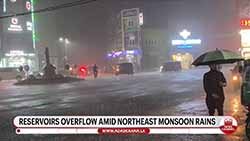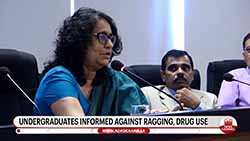Malini Fonseka named among Asiaâs greatest 25
March 4, 2010 10:35 am
The seductive Zhou Xun is arguably
the most adept of
Best Role: In â
Art house darling Gong Li is both
muse and star in Zhang Yimouâs most celebrated films. She made a memorable
debut in 1987âs âRed Sorghum,â following up with âRaise the Red Lanternâ and
âThe Story of Qiu Ju.â These roles established her, according to Asiaweek, as
âone of the worldâs most glamorous movie stars and an elegant throwback to
Best Role: Chen Kaigeâs âFarewell
My Concubineâ was the first Chinese film to win the Palme dâOr at
One cannot speak of
Best Role: Lingyuâs âThe Goddessâ (1934), in which she plays a devoted mother driven into prostitution, is considered the pinnacle of Chinese silent film.
Leslie Cheung was the leading man
of the mid-1980s to the mid-1990s, starring in a flush of hit movies that are
now considered modern
Best Role: Cheungâs role as an idealistic
young cop in John Wooâs âA Better Tomorrowâ (1986) was widely considered his
debut as a serious actor.
Josephine Siao burst into the
spotlight as a teen idol, playing vengeful heroines in 1960s âwusiaâ films. She
successfully transitioned to adult roles, then poured her soul into education
and charities. Today, Siao is one of the most-loved and prolific members of the
Best Role: In the dramatic comedy
âSummer Snowâ (1995), Siao is a mother struggling to care for her
Alzhiemerâs-ridden father-in-law. The movie took home four Golden Horse Awards
and the Silver Berlin Bear.
Tony Leung is called âAsiaâs
answer to Clark Gableâ and the finest
Best Role: Leung took home Best
Actor at
Toshiro Mifuneâs raw charisma
elevated Akira Kurosawaâs films from the 1950s and 60s into masterpieces. The
director described Mifuneâs talent as matchless. âHe put forth everything
directly and boldly, and his sense of timing was the keenest I had ever seen in
a Japanese actor. And yet with all his quickness, he also had surprisingly fine
sensibilities.â
Best Role: Mifune is best known for playing a temperamental ronin in âThe Seven Samurai.â But I adore his turn as the bandit Tajomaru in âRashomon,â bound by rope and gleefully stamping his feet as he spins his tale of the murder.
Tomisaburo Wakayama descended from
a family of Kabuki performers and is the brother of actor Shintaro Katsu
(Zatoichi.) He reached iconic status as Ogami Itto, the scowling, disgraced
samurai who pushes his son Daigoro around in a cart as he enacts bloody
vengeance.
Best Role: The second film of the
series, âBaby Cart at the River Styxâ (1972) is my favorite. Female ninjas!
Basket-headed assassins! A showdown in the sand dunes!
A Renaissance man, Takeshi Kitano
has written, directed, edited or starred in almost a film per year since the
late 1980s. His roles in âMerry Christmas Mr Lawrence,â âFireworksâ and
âHana-biâ made his name in the global art cinema circuit. The Guardian put it
best: âProlific and diverse, he is the epitome of the modern Japanese spirit --
tough, urban, media-savvy, violent, poker-faced yet oddly sentimental.â
Best Role: Kitano was flawless as
the head instructor of the teenage kill program in âBattle Royaleâ (2000).
Heâs frequently compared to Orson
Welles for directing and starring in films that ushered in a golden era of
Hindi cinema. Because of his soulful acting, Guru Duttâs âPyaasaâ and âKaagaz
Ke Phoolâ are now included among the greatest Indian films of all time.
Best Role: Dutt produced, directed
and starred in Pyaasa (1957), a story of a struggling poet in post-independence
Amitabh Bachchanâs deep voice and
broodiness immortalized him as the âangry young manâ of 1970s Bollywood.
Although films such as âSholayâ made him an action hero, he also successfully
played comic and romantic leads.
Best Role: Bachchanâs role as
Inspector Khanna in âZanjeerâ (1973) cemented his image as a dark and deep
character, triggered to explode.
Pran is the pre-eminent villain of
Hindi cinema, appearing in over 350 films (typically listed last in the opening
credits as ââ¦and Pran.â) He was equally at ease playing a powerful lord or an
impoverished villager. So great is his notoriety as a villain that some Indian
parents dare not name their sons Pran.
Best Role: âUpkaar Upkaarâ (1967)
demonstrated Pranâs versatility and earned him a Filmfare Best Supporting Actor
Award. He surprised audiences by playing a good Samaritan and singing the
chart-topping âRishte naate pyar wafaa sab.â
From the 1940s to 1960s, the
beautiful Nargis starred in many commercially successful as well as critically
acclaimed films. Because of her versatility and natural expression, she is
regarded as one of the greatest actresses in the history of Hindi cinema.
Best Role: Nargis stole the show
in the Oscar-nominated âMother Indiaâ (1957), known as the Indian âGone with
the Wind.â She plays a strong-willed woman, Radha, who survives tragedy after
tragedy.
Meena Kumari is famous for playing
grief-stricken parts that mirrored the sufferings in her private life. Dubbed
âThe Tragedy Queen,â Kumari starred in more than 90 films in a career that
spanned from 1939 to her premature death by cirrhosis in 1972. Many of her
works, such as âBaiju Bawraâ and âParineeta,â are considered classics today.
Best Role: Kumariâs troubles in
âSahib Bibi Aur Ghulamâ (1962) were eerily similar to her own: alcoholism,
destructive relationships, the yearning to be understood.
Mohammad Ali is immortalized as
âThe Emperor of Emotionsâ and
Best Role: Ali was confined to
villain roles until âShararatâ (1964), in which he played a hero. The movie was
a hit and opened him up to playing diverse characters.
Zeba was married to Mohammad Ali and is one of the most celebrated Pakistani actresses. Her beauty and passion shone on the screen, and her skills as an actress grew more eloquent over time.
Best Role: Zebaâs performance in
âArmaanâ (1966) is cited as one of her best. It was the first Urdu film to play
for 75 weeks in
The Queen of Sinhalese cinema had
a diverse career that spanned many decades, beginning with her moving
performance in 1968âs âPunchi Baba.â Malini Fonseka was the first Sri Lankan
actress to reach international heights, winning awards at the Moscow
International Film Festival in 1975 and New Delhi Film Festival in 1977.
Best Role: âNidhanayaâ (1972) is
known as one of the best works in
Ever since his blazing debut as a
child actor in the early 1960s, Ah Sung-kiâs nuanced, natural style has won
respect from audiences and critics alike. Known as the National Best Actor, he
starred in some of
Best Role: Sung-ki gained
significant notice for his role as a working-class young man in Lee Jang-hoâs
âFine Windy Dayâ (1980). He was rewarded with a Grand New Bell award for Best
New Actor.
Shim Eun-ha became the most
talked-about actress in
Best Role: Eun-haâs subtle acting
made a profound impact in the romantic tragedy, âChristmas in Augustâ (1998).
The film had over 400,000 screenings in
For over 20 years, Ng Chin Han has
delighted audiences with his theatrical, film and TV performances. He is one of
Best Role: Han was the suave,
silver-tonged
Fann Wong is a triple threat --
actress, singer, model -- and one of the first Singaporean stars to have a role
in a major
Best Role: Wongâs role as a
wayward teenager in âThe Truth About Jane and Samâ (1999) introduced her to a
wide slate of moviegoers and won her a nomination for Best New Performer at the
Hong Kong Film Awards.
The first lady of Thai cinema, Petchara Chaowarat is lovingly recognized by audiences by her sparkling âpuppy dog eyesâ and elaborate up-dos. She starred in around 300 films from 1961 to 1979, and won a Best Actress statue at the 1964 Thailand National Film Awards.
Best Role: One of Chaowaratâs most
popular films was âMonrak luk thungâ (1970), a musical romance where she played
a wealthy woman in love with a rural man.
Mitr Chaibanchaâs dazzling smile
shines over Thai cinema. He churned out 266 films between 1956 and 1970. Today,
fans still visit the shrine erected on the spot where he was killed during the
filming of âInsee Thong.
Best Role: One of Chaibanchaâs
best-known movies, âPet Tad Pet (Operation Bangkok)â (1967), was a top quality
collaboration between
Best Role: Ramlee directed and
acted in âAli Baba Bujang Lapokâ (1960), a rip-roaring Malay spin on the tale
of Ali Baba and the 40 Thieves.
Kong Som Eurn is the unrivaled icon of Cambodian cinema. The handsome actorâs filmography reads like a list of Khmer greatest hits: âOrn Ery Srey Orn,â âMuy Mern Arlai (Missing You 10,000 Times),â âPail Dael Trov Yom (The Time to Cry).â He starred in more than half of all the local films made between 1967 and 1975.
Best Role: âOrn Euy Srey Ornâ
(1972) is a well-loved melodrama. Eurn stands out as a sympathetic farmer who
struggles to marry his beloved while a rich man plots to steal her.












